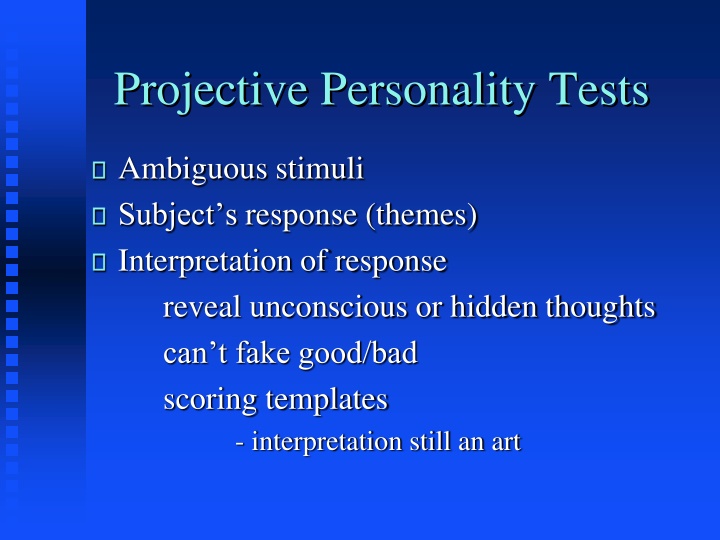
Unraveling the Depths: Projective Personality Test Insights
Delve into the intriguing world of projective personality tests that utilize ambiguous stimuli to reveal hidden thoughts and emotions. Explore various types of tests, including completion, associations, and the Rorschach Inkblot Test. Understand the art of interpretation and uncover the unconscious realms of the human mind.
Download Presentation

Please find below an Image/Link to download the presentation.
The content on the website is provided AS IS for your information and personal use only. It may not be sold, licensed, or shared on other websites without obtaining consent from the author. If you encounter any issues during the download, it is possible that the publisher has removed the file from their server.
You are allowed to download the files provided on this website for personal or commercial use, subject to the condition that they are used lawfully. All files are the property of their respective owners.
The content on the website is provided AS IS for your information and personal use only. It may not be sold, licensed, or shared on other websites without obtaining consent from the author.
E N D
Presentation Transcript
Projective Personality Tests Ambiguous stimuli Subject s response (themes) Interpretation of response reveal unconscious or hidden thoughts can t fake good/bad scoring templates - interpretation still an art
Types of projective tests Completion (sentences or stories) Associations (to words or pictures) Construction (to stimuli) Arrangement (of stimuli - e.g. pictures) Expression (drawing or play)
Completion Sentence completion My best characteristic is My greatest fear is I only wish my mother had . Story completion
Associations Free association Word association Ambiguous stimuli
Rorschach Inkblot Test Herman Rorschach(1921)
10 bilaterally symmetrical images (5 black/white, 2 gray/red, 3 multi) predetermined sequence repeat sequence up to 3 times Exner s scoring system
Scoring the Rorschach Major Criteria Location (where on the inkblot?) Determinant (what feature is used?) form, movement, color, texture Content (what was the percept?) human, human detail, explosion, X-ray Popular versus Original
Construction (adult) Of stories - tests for adults Thematic Apperception Test (TAT) Murray - 1943 ages 14 - 40 30 pictures - 1 blank shown in two sessions of 10 pictures pictures used varies
TAT story elements: Event shown in the picture What has led up to it What the characters in the picture are feeling and thinking Outcome of the event
Construction (children) Of stories The Blacky Pictures (1946) Gerald Blum 5 to adult psychoanalytic 12 pictures (cartoons of animals) makes up story also answers 6-7 questions about each
Construction Of stories - tests for children Children s Apperception Test (CAT) Leopold Bellak (1950) ages 3 to 10 CAT-A = animals in human context CAT-H = uses human figures CAT-S = animal figures in family situations 10 jigsaw like pictures - can manipulate them
Construction Of stories - multicultural Tell-Me-A-Story (TEMAS) (1988/1993) Costanintino, Malgady & Rogler ages 5 -18 23 pictures 11 sex-specific (x2) Hispanic and African-American or White in Urban settings
Expression Symbolic play
Drawings - link Draw a Person (Florence Goodenough - 1926) -- children 3-17 -- difficulties with social adjustment I would like you to draw a picture of a person Now - a person of the opposite sex Tell a story about the person
House-Tree-Person - link John Buck (1948) Anyone over age 3 May be on 1 or 3 sheets of paper House = child s feelings to family Tree = feelings of strength or weakness Person = child s self-concept
